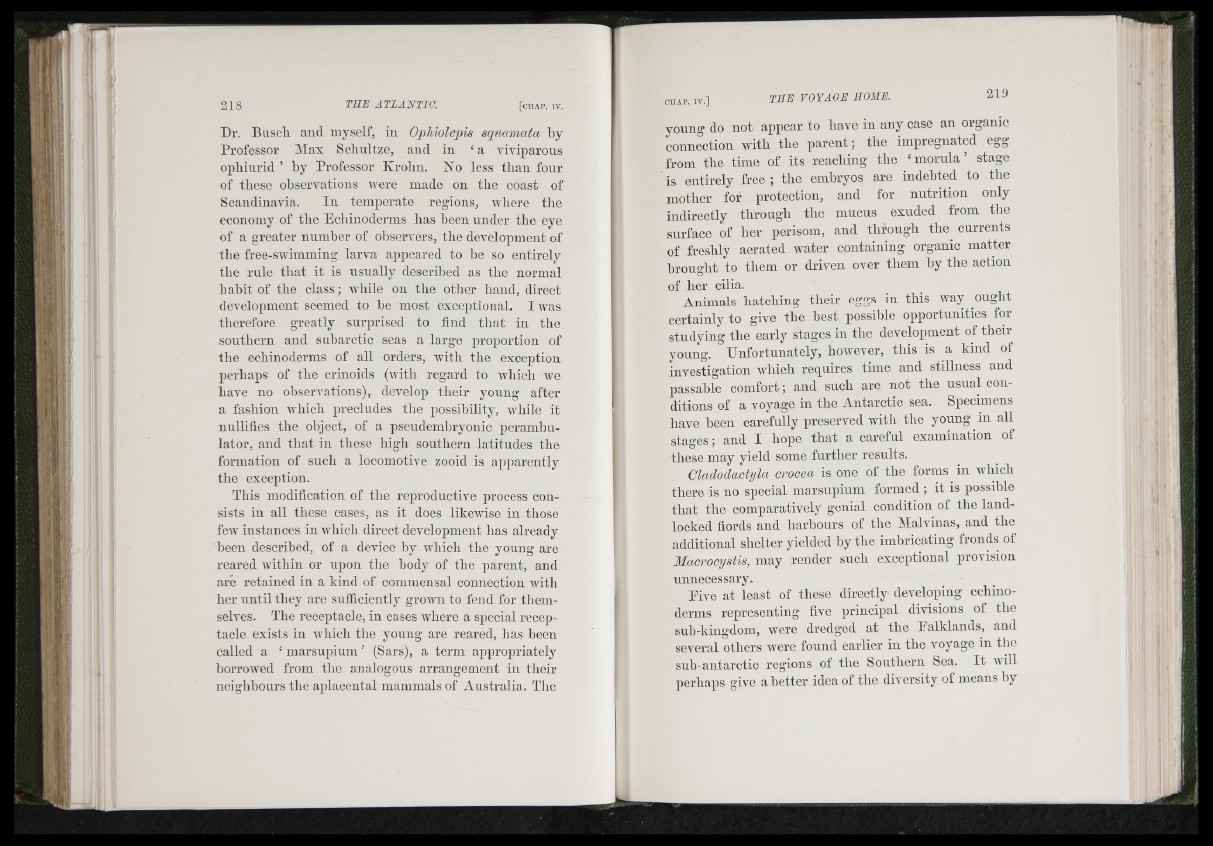
Dr. Buscli and myself, in O p liio le p is s q u a m a ta by
Professor Max Scliultze, and in ‘ a A’iviparous
ophiurid ’ by Professor Krolm. No less than four
of these ohserA'ations were made on the coast of
ScandinaA'ia. In temperate regions, Avhere the
economy of the Echinoderms has heen under the eye
of a greater number of obserA'ers, tbe deA'elopment of
the free-swimming larA'a appeared to be so entirely
tbe rule th a t it is usually described as the normal
habit of the class; while on the other hand, direct
deA'elopment seemed to he most exceptional. I AA'as
therefore greatly surprised to find th a t in the
southern and subarctic seas a large proportion of
the echinoderms of all orders, with the exception
perhaps of the crinoids (Avith regard to Avhich we
have no ohserA'ations), develop their young after
a fashion Avhich precludes the possibility, Avhile it
nullifies the object, of a psendemhryonic perambulator,
and th a t in these bigh southern latitudes the
formation of such a locomotive zooid is apparently
the exception.
This modification of the reproductive process consists
in all these cases, as it does likeAvise in those
feAV instances in whicli direct development has already
heen described, of a device by which the young are
reared within or upon the hody of the parent, and
are retained in a kind of commensal connection with
her u n til they are sufliciently groAvn to fend for themselves.
The receptacle, in cases Avhere a special receptacle
exists in Avhich the young are reared, has heen
called a ‘ marsupium ’ (Sars), a term appropriately
borroAved from the analogous arrangement in their
neighbours the aplacental mammals of Australia. The
yonng do not appear to have in any case an organic
connection with the p a ren t; the impregnated egg
from the time of its reaching the ‘ morula ’ stage
is entirely free ; the embryos are indebted to the
mother for protection, and for n utrition only
indirectly through the mucus exuded from the
surface of her perisom, and through the^ currents
of freshly aerated water containing organic matter
brought to them or driven over them hy the action
of her cilia.
Animals hatching their eggs in this way ought
certainly to give the best possible opportunities for
studying the early stages in the development of their
young. Unfortunately, hoAvever, this is a kind of
investigation Avhich requires time and stillness and
passable comfort ; and such are not the usual conditions
of a voyage in the Antarctic sea. Specimens
have heen carefully preserved with the young in all
stages; and I hope th a t a careful examination of
these may yield some further results.
C la d o d a c tijla c r o c e a is one of the forms in AA'hich
there is no special marsupium formed ; it is possible
th at the comparatively genial condition of the landlocked
fiords and harbours of the Malvinas, and the
additional shelter yielded by the imbricating fronds of
M a c r o c y s t i s , may render such exceptional provision
unnecessary.
Pive at least of these directly developing echinoderms
representing five principal divisions of the
sub-kingdom, were dredged at the Palklands, and
several others were found earlier in the voyage in the
sub-antarctic regions of the Southern Sea. It Avill
perhaps give abetter idea of the diversity of means hy